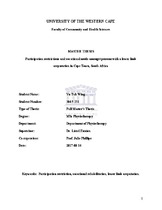| dc.contributor.advisor | Ennion, Liezel | |
| dc.contributor.advisor | Phillips, Julie | |
| dc.contributor.author | Wing, Yu Tak | |
| dc.date.accessioned | 2018-08-15T09:45:28Z | |
| dc.date.available | 2018-08-15T09:45:28Z | |
| dc.date.issued | 2017 | |
| dc.identifier.uri | http://hdl.handle.net/11394/6299 | |
| dc.description | Masters of Science - Msc (Physiotherapy) | |
| dc.description.abstract | Vocational rehabilitation relates to rehabilitating a person with an amputation back into actively
participating in society. Although vocational rehabilitation is important, before it can be
implemented, the participation restrictions should be identified. Even though lower limb
amputation surgery is commonly performed in South Africa, and given the high unemployment
rate in the country, no research has been done into the participation restrictions and vocational
needs of a person with a unilateral lower limb amputation in the Western Cape. The aim of this
study was to determine and explore the participation restrictions and vocational rehabilitation
needs in terms of hobbies, sport activities, employment and employment needs of persons with
a unilateral lower limb amputation (LLA) in the Western Cape. The objectives were to: 1)
Determine the participation restrictions of persons with a unilateral LLA in the Western Cape.
2) To explore the vocational rehabilitation needs of persons with a lower limb amputation. A
mixed methods approach, and an explanatory sequential design was used in this study. The
study was conducted in two phases. The first phase utilised a quantitative approach and the
WHODAS 2.0 was used as the instrument to collect data. The second phase aimed to explain
the data collected in the first phase in more depth, and semi-structured telephonic interviews
were utilized to collect the qualitative data. The study was set in the Cape Metropole region of
the Western Cape. Participants were recruited from Tygerberg Tertiary Hospital and a private
sub-acute rehabilitation centre. In the quantitative (first) phase of the study, 50 participants were
conveniently recruited to participate. In the second phase eight participants were purposefully
selected from the pool of 50 participants from the first phase of the study who consented to
participate in the second phase. Quantitative data was analysed using SPSS vs. 22 and analysed
for descriptive and inferential statistics. Qualitative data has been analysed using Creswell's
seven step process of thematic analysis. Ethical clearance has been obtained from the University
of the Western Cape, permission to access patients' details has been obtained from Tygerberg
Tertiary Hospital and private sub-acute rehabilitation centre. Written informed consent as well
as permission for audio recording during the telephonic interview was obtained. | |
| dc.language.iso | en | |
| dc.publisher | University of the Western Cape | |
| dc.subject | Participation restriction | |
| dc.subject | Vocational rehabilitation | |
| dc.subject | Lower limb amputation | |
| dc.title | Participation restrictions and vocational needs amongst persons with a lower limb amputation in Cape Town, South Africa | |
| dc.rights.holder | University of the Western Cape | |

